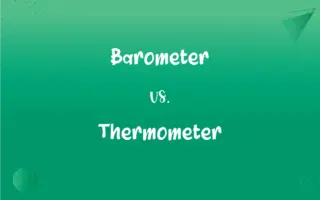NPN Transistor vs. PNP Transistor: What's the Difference?
Edited by Aimie Carlson || By Harlon Moss || Updated on October 30, 2023
An npn transistor uses an n-type material sandwiched between two p-type materials; a pnp transistor has a p-type material between two n-type materials.

Key Differences
An npn transistor consists of a layer of p-type semiconductor between two n-type semiconductors. The pnp transistor, on the other hand, consists of an n-type semiconductor placed between two p-type semiconductors. In an npn transistor, the current flows from the collector to the emitter, which is typically from a positive to a negative region. Contrarily, in a pnp transistor, the current flows from the emitter to the collector, essentially moving from a negative to a positive region.
The npn transistor is typically preferred in circuits where current needs to be sourced, i.e., drawn towards the load. The pnp transistor, conversely, is more suitable in situations where the current needs to be sunk, or directed away from the load. This fundamental difference makes the npn transistor more common in modern electronic designs, while the pnp transistor is often used in complementary or push-pull configurations.
The biasing of an npn transistor requires the base voltage to be higher than the emitter, while the pnp transistor requires the base voltage to be lower than the emitter. This means that the npn transistor turns on, or conducts, when a positive voltage is applied to its base. On the other hand, the pnp transistor turns on when a negative voltage is applied to its base.
Both npn and pnp transistors serve as essential building blocks in electronic circuits, offering amplification and switching functionalities. While the operational principles of both transistors are quite similar, the direction of current flow and the type of biasing required are what distinctly separate the npn transistor from the pnp transistor.
Regardless of the differences, both npn and pnp transistors are complementary and can often be found together in various circuits, ensuring efficient operation and maximizing performance.
ADVERTISEMENT
Comparison Chart
Configuration
N-P-N layering
P-N-P layering
Current Flow
From collector to emitter
From emitter to collector
Common Usage
Sourcing current
Sinking current
Base Voltage to Turn On
Positive voltage
Negative voltage
Material Sandwiched in Middle
P-type material
N-type material
ADVERTISEMENT
NPN Transistor and PNP Transistor Definitions
NPN Transistor
The npn transistor's emitter is typically connected to the ground.
In our circuit, the npn transistor's emitter is directly grounded.
PNP Transistor
The pnp transistor primarily uses holes as charge carriers.
In a pnp transistor, holes move from the emitter to the collector.
NPN Transistor
The npn transistor has electrons as its primary charge carriers.
In an npn transistor, electrons move from the emitter to the collector.
PNP Transistor
Pnp transistors are often used to sink current away from a load.
I incorporated a pnp transistor in my circuit to effectively sink current.
NPN Transistor
An npn transistor conducts when a positive voltage is applied to its base.
I used an npn transistor to switch on the LED when a signal is detected.
PNP Transistor
The pnp transistor conducts when a negative voltage is applied to its base.
To turn on the pnp transistor, I applied a negative voltage to its base.
NPN Transistor
An npn transistor is commonly used to source current in a circuit.
I chose the npn transistor for my design because it efficiently sources current.
PNP Transistor
A pnp transistor is a bipolar junction transistor with a P-N-P configuration.
The amplifier I built uses a pnp transistor for the output stage.
NPN Transistor
An npn transistor is a type of bipolar junction transistor with N-P-N layering.
The npn transistor is a crucial component in many amplification circuits.
PNP Transistor
The pnp transistor's emitter is usually connected to a positive voltage.
In our setup, the pnp transistor's emitter is tied to the positive rail.
FAQs
How does current flow in an npn transistor?
In an npn transistor, current flows from the collector to the emitter.
What is the function of the base in these transistors?
The base controls the flow of current between the collector and emitter.
Which layer is in the center of a pnp transistor?
An n-type material is in the center of a pnp transistor.
Which transistor is commonly used for sourcing current?
The npn transistor is typically used for sourcing current.
What are the primary charge carriers in an npn transistor?
Electrons are the primary charge carriers in an npn transistor.
Are these transistors used in digital circuits?
Yes, both npn and pnp transistors are used in digital circuits for switching operations.
Are there integrated circuits (ICs) that include these transistors?
Yes, many ICs incorporate both npn and pnp transistors for various functions.
What is an npn transistor?
An npn transistor is a bipolar junction transistor with an N-P-N layer configuration.
Can both transistors amplify signals?
Yes, both npn and pnp transistors can amplify signals.
Why is biasing important for these transistors?
Biasing determines whether the transistor is on or off and influences its operation.
Can these transistors be used in power applications?
Yes, both types can be used in power applications with appropriate ratings.
What is a pnp transistor?
A pnp transistor is a bipolar junction transistor with a P-N-P layer configuration.
How does current flow in a pnp transistor?
In a pnp transistor, current flows from the emitter to the collector.
Which transistor is used for sinking current?
The pnp transistor is used for sinking current.
What turns on an npn transistor?
An npn transistor turns on when a positive voltage is applied to its base.
What turns on a pnp transistor?
A pnp transistor turns on when a negative voltage is applied to its base.
Are npn and pnp transistors used together?
Yes, they are often used together in complementary or push-pull configurations.
Which transistor is more common in modern electronics?
The npn transistor is more common in modern electronic designs.
What are the primary charge carriers in a pnp transistor?
Holes are the primary charge carriers in a pnp transistor.
Which layer is sandwiched in the middle of an npn transistor?
A p-type material is sandwiched in the middle of an npn transistor.
About Author
Written by
Harlon MossHarlon is a seasoned quality moderator and accomplished content writer for Difference Wiki. An alumnus of the prestigious University of California, he earned his degree in Computer Science. Leveraging his academic background, Harlon brings a meticulous and informed perspective to his work, ensuring content accuracy and excellence.
Edited by
Aimie CarlsonAimie Carlson, holding a master's degree in English literature, is a fervent English language enthusiast. She lends her writing talents to Difference Wiki, a prominent website that specializes in comparisons, offering readers insightful analyses that both captivate and inform.






































































